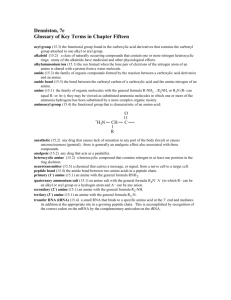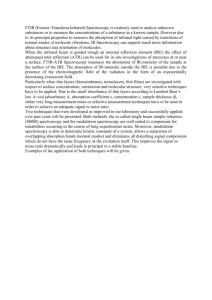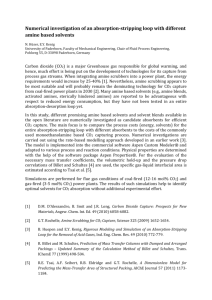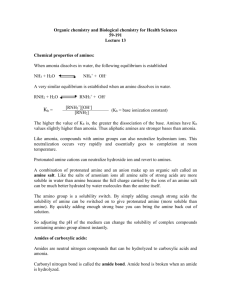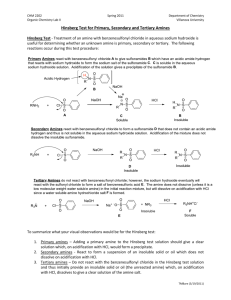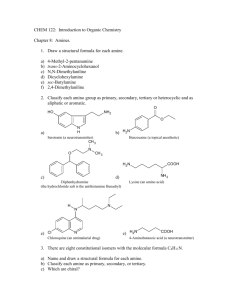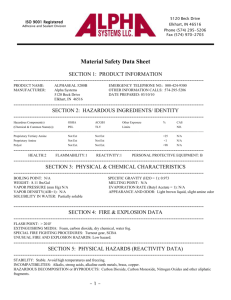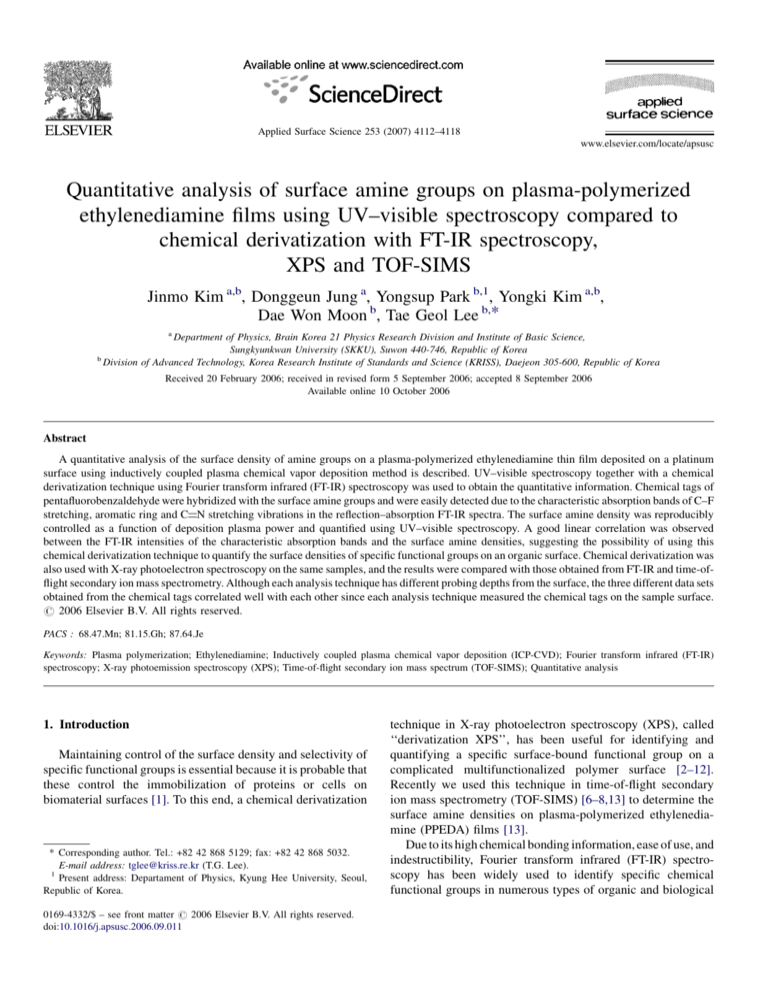
Applied Surface Science 253 (2007) 4112–4118
www.elsevier.com/locate/apsusc
Quantitative analysis of surface amine groups on plasma-polymerized
ethylenediamine films using UV–visible spectroscopy compared to
chemical derivatization with FT-IR spectroscopy,
XPS and TOF-SIMS
Jinmo Kim a,b, Donggeun Jung a, Yongsup Park b,1, Yongki Kim a,b,
Dae Won Moon b, Tae Geol Lee b,*
a
Department of Physics, Brain Korea 21 Physics Research Division and Institute of Basic Science,
Sungkyunkwan University (SKKU), Suwon 440-746, Republic of Korea
b
Division of Advanced Technology, Korea Research Institute of Standards and Science (KRISS), Daejeon 305-600, Republic of Korea
Received 20 February 2006; received in revised form 5 September 2006; accepted 8 September 2006
Available online 10 October 2006
Abstract
A quantitative analysis of the surface density of amine groups on a plasma-polymerized ethylenediamine thin film deposited on a platinum
surface using inductively coupled plasma chemical vapor deposition method is described. UV–visible spectroscopy together with a chemical
derivatization technique using Fourier transform infrared (FT-IR) spectroscopy was used to obtain the quantitative information. Chemical tags of
pentafluorobenzaldehyde were hybridized with the surface amine groups and were easily detected due to the characteristic absorption bands of C–F
stretching, aromatic ring and C N stretching vibrations in the reflection–absorption FT-IR spectra. The surface amine density was reproducibly
controlled as a function of deposition plasma power and quantified using UV–visible spectroscopy. A good linear correlation was observed
between the FT-IR intensities of the characteristic absorption bands and the surface amine densities, suggesting the possibility of using this
chemical derivatization technique to quantify the surface densities of specific functional groups on an organic surface. Chemical derivatization was
also used with X-ray photoelectron spectroscopy on the same samples, and the results were compared with those obtained from FT-IR and time-offlight secondary ion mass spectrometry. Although each analysis technique has different probing depths from the surface, the three different data sets
obtained from the chemical tags correlated well with each other since each analysis technique measured the chemical tags on the sample surface.
# 2006 Elsevier B.V. All rights reserved.
PACS : 68.47.Mn; 81.15.Gh; 87.64.Je
Keywords: Plasma polymerization; Ethylenediamine; Inductively coupled plasma chemical vapor deposition (ICP-CVD); Fourier transform infrared (FT-IR)
spectroscopy; X-ray photoemission spectroscopy (XPS); Time-of-flight secondary ion mass spectrum (TOF-SIMS); Quantitative analysis
1. Introduction
Maintaining control of the surface density and selectivity of
specific functional groups is essential because it is probable that
these control the immobilization of proteins or cells on
biomaterial surfaces [1]. To this end, a chemical derivatization
* Corresponding author. Tel.: +82 42 868 5129; fax: +82 42 868 5032.
E-mail address: tglee@kriss.re.kr (T.G. Lee).
1
Present address: Departament of Physics, Kyung Hee University, Seoul,
Republic of Korea.
0169-4332/$ – see front matter # 2006 Elsevier B.V. All rights reserved.
doi:10.1016/j.apsusc.2006.09.011
technique in X-ray photoelectron spectroscopy (XPS), called
‘‘derivatization XPS’’, has been useful for identifying and
quantifying a specific surface-bound functional group on a
complicated multifunctionalized polymer surface [2–12].
Recently we used this technique in time-of-flight secondary
ion mass spectrometry (TOF-SIMS) [6–8,13] to determine the
surface amine densities on plasma-polymerized ethylenediamine (PPEDA) films [13].
Due to its high chemical bonding information, ease of use, and
indestructibility, Fourier transform infrared (FT-IR) spectroscopy has been widely used to identify specific chemical
functional groups in numerous types of organic and biological
J. Kim et al. / Applied Surface Science 253 (2007) 4112–4118
samples. In particular, the surfaces of organic thin layers [12,14–
44], including plasma deposited films (PDFs) [12,27–40], have
been characterized using attenuated total reflection [12,29–44]
and reflection–absorption FT-IR [14–25], which can probe the
surface region [26]. Despite the advantages, however, FT-IR has
normally played an ancillary role in the quantification of specific
surface chemical compositions; functional groups are usually
analyzed using better quantitative surface analysis techniques,
such as XPS [7,23,28,35–38], mainly because the extinction
coefficients for organic thin layers are unknown in FT-IR. To
compensate for this, several studies have quantified organic thin
layers by using FT-IR spectroscopy with another technique such
as XPS [12,16,24], electrochemical impedance spectroscopy
[17], surface acoustic wave [18], surface plasmon resonance [20]
or quartz crystal balance [25].
In our study, we examined PPEDA films, which are pinhole
free, mechanically and chemically stable, and adhere strongly
to the substrate owing to their highly cross-linked network
structures [45–49]. PPEDA films can be deposited relatively
quickly and uniformly with good control of thickness and
functional group density to produce a high-quality amine
functionalized glass surface for the immobilization of proteins
[46,50]. We used UV–visible absorption spectroscopy and a
chemical derivatization technique with FT-IR reflection–
absorption spectroscopy to quantify the surface density of
amine groups on the PPEDA film. As a chemical tagging
molecule, pentafluorobenzaldehyde (PFBA) was hybridized
with the surface amine group. The surface amine density was
systematically changed by varying the plasma power and was
independently determined by UV–visible absorption spectroscopy. The results of the FT-IR and UV–visible measurements
were compared, and a correlation curve for quantification was
obtained. For comparison, a correlation curve of the XPS and
UV–visible measurements was also obtained and compared
with those of the FT-IR and TOF-SIMS studies.
2. Experimental methods
2.1. Reagents
Ethylenediamine was used as the monomer and was
purchased from Sigma–Aldrich (St. Louis, MO, USA). PFBA
and 4-nitrobenzaldehyde were also purchased from Sigma–
Aldrich.
2.2. Fabrication of PPEDA films
The method by which the PPEDA films were deposited on
the substrate has been reported in detail, elsewhere [50]. The
following is a brief description. The PPEDA films were
deposited on the substrate at room temperature with a
deposition pressure of 30 mTorr, a deposition time of 2 min
and an Ar flow rate of 30 sccm. The monomer, ethylenediamine, was vaporized in a stainless steel bubbler at 50 8C. Two
plasmas were used to produce a high-quality amine surface.
The inductively coupled plasma (ICP) power varied from 3 to
70 W and was generated around the shower ring by a circular
4113
coil, which was connected to a 13.56 MHz radio frequency (rf)
generator through a matching box. The 3 W of fixed substrate
bias was generated from another rf generator and was put into a
substrate holder for plasma around the glass slide. The wall of
the deposition chamber was grounded, and the base pressure
was <10 6 Torr when pumped with a turbo molecular pump.
2.3. UV–visible measurements
To determine the surface amine density of the PPEDA film,
we used UV–visible absorption spectrometry, with minor
changes, as described in Park and co-workers [51]. In a nitrogen
atmosphere, a PPEDA-coated glass slide (1.5 cm 2.5 cm)
was allowed to react with excess 4-nitrobenzaldehyde (10 mg)
anhydrous ethanol solution (25 mL) overnight at 50 8C. After
the Schiff base reaction, the substrate was thoroughly washed
and sonicated with absolute ethanol, methylene chloride,
acetone and hexane for 3 min each sequentially and dried in a
vacuum. The same procedures were used for the hybridization
reaction with PFBA (1 mg). The chemically tagged substrate
was then submitted for FT-IR analysis before hydrolysis. To
hydrolyze, the imine-formed substrate was immersed in 1 mL
of water overnight at 50 8C. The aqueous solution of
hydrolyzed 4-nitrobenzaldehyde (emax = 1.45 104 M 1
cm 1) was measured with an HP 8453 UV–visible spectrophotometer (Hewlett-Packard). All spectra were recorded after
baseline correction and were converted to surface amine
density in accordance with Beer’s law.
2.4. FT-IR analysis
Polarized infrared external reflectance spectroscopy was used
to obtain spectra in a single reflection mode using a nitrogenpurged thermo Nicolet Nexus Fourier transform infrared (FT-IR)
spectrometer. The p-polarized light was incident at 808 from the
surface normal. We used a narrow band mercury–cadmium–
telluride detector for the reflected light and averaged 1024 scans,
yielding the spectrum at a resolution of 4 cm 1. The sample
compartment was purged with dry CO2-free air. Data
manipulation was restricted to manually correcting the baseline
for display purposes. Positions, band maxima and integral band
areas were evaluated from the raw data.
2.5. XPS analysis
XPS was performed using an ESCA 220i system equipped
with a hemispherical analyzer and electron flood gun for
charging compensation. The X-ray source of 1486.6 eV was
generated using an aluminum anode at 15 kV, and the takeoff
angle was adjusted to be normal to the sample surface. The
pressure in the analysis chamber was <5 10 11 Torr. The pass
energy was 50 eV for survey spectra and 30 eV for narrow scans.
We used 285.0 eV for the C 1s binding energy to correct the
charging effect. For all of the samples, the signal intensities were
normalized to the signal intensity of the platinum substrate (Pt
4f). The sensitivity factors were F 1s = 1.00, C 1s = 0.25, N
1s = 0.42 and O 1s = 0.66. The atomic concentration of each
4114
J. Kim et al. / Applied Surface Science 253 (2007) 4112–4118
element was calculated by determining the relevant integral peak
intensity. Shirley method of background removal was used in
conjunction with least square fitting algorithm employing full
Voigt functions.
2.6. TOF-SIMS analysis
TOF-SIMS measurements were obtained with a TOF-SIMS
V instrument (ION-TOF GmbH, Germany) using 25 keV Au+
primary ions (average current of 0.8 pA, pulse width of 16.8 ns
and repetition rate of 5 kHz) in high-current bunched mode.
The analysis area of 100 mm 100 mm was randomly rastered
by primary ions and charge compensated by low-energy
electron flooding. The primary ion dose was kept below
1012 ions cm 2 to ensure static SIMS condition. Mass
resolution was usually over 5000 in both positive and negative
modes. The mass calibrations of the positive and negative ion
spectra were performed internally using H+, H2+, CH3+, C2H3+
and C3H4+ peaks and H , C , CH , C2 and C2H peaks,
respectively.
was then measured, and, using the known surface area of the
substrate, the result was used to calculate the surface density of
the reactive amine groups.
We applied Park’s UV–visible spectrometric method to our
analysis of PPEDA-coated surfaces, which were produced using
six different ICP powers: 3, 5, 10, 30, 50 and 70 W. The 4nitrobenzaldehyde molecules reproduced from the PPEDA
surface generated an absorbance peak at 267 nm, and the
magnitude of this peak decreased as the plasma power increased
from 3 to 70 W. The surface area and volume of water are known,
so the absorbance data can be converted into surface amine
density using Beer’s law. The calculated surface densities of
reactive amine groups as a function of plasma power were
5.4 amine groups nm 2 at 3 W, 4.4 amine groups nm 2 at 5 W,
3.6 amine groups nm 2 at 10 W, 3.2 amine groups nm 2 at
30 W, 2.9 amine groups nm 2 at 50 W and 2.7 amine groups
nm 2 at 70 W. These densities were correlated with the densities
obtained from the FT-IR measurements.
3.2. Chemical derivatization technique using FT-IR
spectroscopy
3. Results and discussion
3.1. UV–visible absorption spectrometric study
To study the usefulness of chemical derivatization with FTIR in a quantitative analysis, the surface density of the amine
groups on the PPEDA thin film must first be determined. Park
and co-workers [51] successfully used UV–visible spectroscopy to measure the surface density of amine groups on
aminosilylated thin layers by converting the non-absorbing
amine groups into nitrobenzyl-substituted imines, which could
be detected by UV–visible spectroscopy. A large excess of 4nitrobenzaldehyde was allowed to react with the amine groups
to form imines (Scheme 1), which were hydrolyzed in a known
volume of water to reproduce 4-nitrobenzaldehyde. The
absorbance of the reproduced 4-nitrobenzaldehyde molecules
Six PPEDA-coated thin films produced using different
plasma powers were allowed to react with PFBA and were
measured using FT-IR spectroscopy (Scheme 1). The absorption spectra of the PPEDA films before and after reacting with
PFBA are shown in Fig. 1a and b, respectively. As expected, the
spectra of PPEDA thin films before chemical tagging show
numerous complex absorption peaks, due mainly to aliphatic
hydrocarbons containing nitrogen and oxygen (Fig. 1a). After
chemical tagging, however, several new absorption peaks make
their appearance at 1650, 1595 and 1013 cm 1, as shown in
Fig. 1b.
The presence of amine functional groups on PPEDA thin
films is indicated by the vibrations of N–H asymmetric
stretching, N–H symmetric stretching, the overtone of N–H
deformation and N–H primary amine deformation, which give
Scheme 1.
J. Kim et al. / Applied Surface Science 253 (2007) 4112–4118
4115
Fig. 1. FT-IR spectra of PPEDA thin films (a) before and (b) after chemical tagging with PFBA. Films were deposited using six different plasma powers from 3 to
70 W.
rise to peaks at 3353, 3262, 3175 and 1585 cm 1, respectively
[12,28,38,52]. The intensities of the amine-related peaks,
including the peak related to the primary amine deformation
vibration at 1585 cm 1, decrease as the deposition plasma
power increases (i.e. as the surface amine density decreases).
These results are consistent with the results obtained by UV–
visible spectroscopy, which show that the reactive amine
density is highest at the lowest deposition plasma power.
Although the amine-related peaks were not sufficiently distinct
from the other absorption peaks for further quantitative
analysis, the absorption peaks obtained after chemical
derivatization were distinct enough for us to perform an
assignment of each absorption peaks. In particular, the
separation of the peaks in the 1800–1000 cm 1 region was
enhanced relative to that of spectra from PPEDA films without
chemical derivatization.
Among several peaks in the 1800–1000 cm 1 region, the
intensities of three new absorption bands at 1650, 1595 and
1013 cm 1 decrease as the deposition plasma power increases
(Fig. 1b) in a way that is similar to the amine-related
absorption peaks at 3353, 3262, 3175 and 1585 cm 1 prior to
chemical tagging. Our UV–visible spectrometric study
showed that the surface density of amine groups on PPEDA
film also decreased as plasma power increased. The similarity
of the results of the UV–visible and FT-IR studies suggests that
new absorption bands are generated by the chemical tag
molecule, PFBA. This in turn suggests that there is a direct
correlation between each amine group and a PFBA tag. In
other words, the more reactive amine groups there are on the
surface, the more PFBA molecules will hybridize with amine
functional groups on the surface. Based on the changes of the
peaks intensities as a function of plasma power and on
previously published literature [12,28,38,52], we tentatively
assigned the peaks at 1650, 1595 and 1013 cm 1 to the
vibrations of C N imine stretching, aromatic ring and C–F
bond stretching, respectively.
In addition to assigning these peaks to vibrations of the
chemical tag molecule, we assign the peaks at 2965, 2911,
2253, 2130, 1720, 1694, 1548, 1454, 1368 and 1214 cm 1 to
the vibrations of CH2 asymmetric stretching, CH2 symmetric
stretching, CBBN stretching, CBBC stretching, C O stretching,
C C stretching, N N stretching, CH2 deformation, CH3
Table 1
Infrared frequencies and vibrational assignments from the spectra of PPEDA
thin films before and after chemical tagging with PFBA
Frequency (cm 1)
PPEDA
Band assignment a
PFBA/PPEDA
3353
3262
3175
2965
2911
2253
2130
1720
1694
1650
1595
1585
1548
1454
1368
1214
1013
a
See Refs. [12,28,38,52].
yas(N–H)
ys(N–H)
overtone of d(N–H)
yas(CH2)
ys(CH2)
y(CBBN)
y(CBBC)
y(C 0)
y(C C)
y(C N), imine formation
yf(aromatic ring), PFBA
d(N–H), primary amine
y(N N)
d(CH2)
d(CH3)
y(C–N)
y(C–F), PFBA
4116
J. Kim et al. / Applied Surface Science 253 (2007) 4112–4118
deformation and C–N stretching, respectively [12,28,38,52].
The intensities of these absorption bands generally increased
as the deposition plasma power increased, regardless of
chemical derivatization. This behavior is typical of plasmapolymerized polymers. Table 1 summarizes the assignments
of infrared absorption bands obtained from PPEDA thin films
before and after chemical derivatization. The normalized
intensities of each of the three new absorption bands were
then plotted against the surface density of amine groups as
determined by UV–visible spectroscopy (Fig. 2). The total
intensity of the absorption bands was used for normalization.
The intensities of the absorption peaks at 1013, 1595 and
1650 cm 1 correlated well (R2 = 0.94, 0.93 and 0.95,
respectively) with the surface amine density, which indicates
the feasibility of quantifying surface amine density with
chemical derivatization with FT-IR spectroscopy. The
correlation curve itself would depend on the type of sample
surface, but the idea of using a chemical derivatization
technique with FT-IR nonetheless warrants further study for
the quantitative analysis of the surface density of any
functional group on general samples, as has been shown in
many XPS studies [2–12].
3.3. Chemical derivatization technique using XPS and
TOF-SIMS
Fig. 2. Correlations between the normalized FT-IR intensities of (a) y(C–F),
(b) yf and (c) y(C N) and surface amine density as determined by UV–visible
spectroscopy.
To compare the quantitative analysis of the FT-IR study, the
same system was studied using XPS. Fig. 3 shows the F 1s and
N 1s binding energy regions of XPS spectra obtained before and
after chemical derivatization of PPEDA thin films deposited
with a range of plasma powers. The F 1s peak, which provides
clear evidence of PFBA on the PPEDA surface, appears in the
XPS spectra only after chemical derivatization. The intensity of
Fig. 3. XPS spectra of F 1s and N 1s obtained from PPEDA thin films (a) before and (b) after chemical tagging with PFBA. Films were deposited using various plasma
powers. The XPS spectra of N 1s intensity, which were scaled with the same peak height, are shown (c) before and (d) after chemical tagging.
J. Kim et al. / Applied Surface Science 253 (2007) 4112–4118
4117
Table 2
Atomic concentrations of carbon, nitrogen, oxygen and fluorine and the ratios of oxygen, nitrogen and fluorine to carbon, calculated from the XPS spectra of PPEDA
thin films before and after chemical tagging with PFBA
ICP power (W)
3
5
10
30
50
70
PPEDA
PFBA/PPEDA
C (%)
N (%)
O (%)
O/C
N/C
C (%)
N (%)
O (%)
F (%)
O/C
N/C
F/C
58.19
60.83
63.72
67.82
71.39
73.23
24.94
23.66
22.39
21.42
20.14
19.47
16.87
15.51
13.89
10.76
8.48
7.30
0.29
0.26
0.22
0.16
0.12
0.10
0.43
0.39
0.36
0.32
0.28
0.27
59.95
61.54
64.04
66.63
69.28
71.78
19.98
19.43
19.13
18.79
18.42
17.94
15.33
14.80
13.12
11.12
9.22
7.80
4.74
4.23
3.71
3.46
3.08
2.48
0.26
0.24
0.20
0.17
0.13
0.11
0.33
0.32
0.30
0.28
0.27
0.25
0.08
0.07
0.06
0.05
0.04
0.03
F 1s decreases as the deposition plasma power increases
(Fig. 3b). The atomic concentrations of carbon, nitrogen,
oxygen and fluorine and the ratios of nitrogen, oxygen and
fluorine to carbon are given in Table 2. Before chemical
derivatization, the main peak of the N 1s peak was at 399.4 eV,
with a shoulder peak at 398.0 eV (Fig. 3c). The intensity of the
main N 1s peak increases as the deposition plasma power
increases, whereas the intensity of the shoulder N 1s peak
decreases as the deposition plasma power increases (Fig. 3a).
These plasma-power dependences of the two N 1s peaks
correspond well with those of the C–N stretching vibration at
1214 cm 1 and the primary amine deformation vibration at
1585 cm 1, respectively (Fig. 1a). In addition, the intensity of
the shoulder N 1s peak is reduced after chemical derivatization
(Fig. 3d). Based on these XPS and FT-IR results, we tentatively
assign the main peak at 399.4 eV to nitrogen in non-reactive
molecules such as amide molecules and the shoulder peak at
398.0 eV to nitrogen in reactive amine molecules [2,12]. We
plotted the normalized intensity of the F 1s XPS peak against
the surface density of amine groups as determined by UV–
visible spectroscopy (Fig. 4). The platinum peak (Pt 4f) was
used as a reference peak for normalization. The F 1s signal
correlates well (R2 = 0.96) with the surface amine density,
indicating that it is feasible to quantify surface amine density
using chemical derivatization in XPS.
We have recently shown that chemical derivatization in TOFSIMS in conjunction with UV–visible absorption spectroscopy is
useful in quantifying surface amine density [13]. In short, TOFSIMS revealed a good correlation between surface amine density
and the secondary-ion signal of the chemical tag molecules.
Thus, all three independent surface-sensitive analysis tools
(reflection–absorption FT-IR, XPS and TOF-SIMS) were
successfully used to quantify the surface density of amine
functional groups, despite their different probing depths of PDFs,
which were approximately 200, 100 and 15 Å, respectively [27].
The different probing depths had no effect on the quantification
of the surface amine density because the chemical derivatization
method and each analysis technique measure only chemical tags
existing on the sample surface. This also resulted in a good
correlation between the results of FT-IR spectroscopy and those
of XPS (R2 = 0.94) and between the results of FT-IR spectroscopy and those of TOF-SIMS (R2 = 0.95) (Fig. 5). Fig. 5 shows
that chemical derivatization using FT-IR spectroscopy, XPS or
Fig. 4. Correlation between the normalized XPS intensity of F 1s and the
surface amine density as determined by UV–visible spectroscopy.
Fig. 5. Correlations between the normalized FT-IR intensity of the y(C–F) peak
and (a) normalized XPS intensity and (b) normalized TOF-SIMS intensity.
4118
J. Kim et al. / Applied Surface Science 253 (2007) 4112–4118
TOF-SIMS can be useful in obtaining quantitative information of
specific reactive functional groups when there are multiple
functional groups on the sample surface, although each analysis
technique has its advantages and disadvantages.
4. Conclusion
We have shown that chemical derivatization in FT-IR
spectroscopy is a useful way of quantifying the surface density
of amine groups on PPEDA films. The surface density of amine
groups was changed by varying the deposition plasma power,
and then quantitatively and independently determined by UV–
visible absorption spectrometry. The densities obtained were
compared with the results of FT-IR spectroscopy using the
chemical derivatization technique. We found good linear
correlations between the surface density of amine groups and
the normalized intensities of each of the new absorption peaks.
We tentatively assigned the new absorption bands to vibrations
within the chemical tag molecules. Chemical derivatization in
XPS was also performed on the same system, and the results
were compared with those from FT-IR spectroscopy and TOFSIMS. The results of the comparison indicate that chemical
derivatization in all three independent surface-sensitive
analysis tools can be used to quantify surface amine density.
Acknowledgments
This work was supported by the R&D Program of Fusion
Strategies for Advanced Technologies of MOCIE and grants
from the KRIBB Intitiative Research Program (KRIBB,
Korea).
References
[1]
[2]
[3]
[4]
[5]
[6]
[7]
[8]
[9]
[10]
[11]
[12]
D.G. Castner, B.D. Ratner, Surf. Sci. 500 (2002) 28.
D.S. Everhart, C.N. Reilley, Anal. Chem. 53 (1981) 665.
D. Briggs, C.R. Kendall, Int. J. Adhes. Adhes. (1982) 13.
J. Lub, F. Vroonhoven, E. Bruninx, A. Benninghoven, Polymer 30 (1989)
40.
H.J. Griesser, R.C. Chatelier, J. Appl. Polym. Sci.: Appl. Polym. Symp. 46
(1990) 361.
A. Chilkoti, D.G. Castner, B.D. Ratner, D. Briggs, J. Vac. Sci. Technol. A 8
(3) (1990) 2274.
A. Chilkoti, B.D. Ratner, D. Briggs, Chem. Mater. 3 (1991) 51.
A. Chilkoti, B.D. Ratner, D. Briggs, Anal. Chem. 63 (1991) 1612.
A. Chilkoti, B.D. Ratner, D. Briggs, Anal. Chem. 65 (1993) 1736.
T.K. Markkula, J.A. Hunt, F.R. Pu, R.L. Williams, Surf. Interf. Anal. 34
(2002) 583.
A.A. Meyer-Plath, K. Schröder, B. Finke, A. Ohl, Vacuum 71 (2003) 391.
A. Choukourov, H. Biederman, I. Kholodkov, D. Slavinska, M. Trchova,
A. Hollander, J. Appl. Polym. Sci. 92 (2004) 979.
[13] J. Kim, H.K. Shon, D. Jung, D.W. Moon, S.Y. Han, T.G. Lee, Anal. Chem.
77 (2005) 4137.
[14] B.L. Frey, R.M. Corn, Anal. Chem. 68 (1996) 3187.
[15] D.G. Hanken, R.M. Corn, Anal. Chem. 67 (1995) 3767.
[16] J.C. Love, D.B. Wolfe, R. Haasch, M.L. Chabinyc, K.E. Paul, G.M.
Whitesides, R.G. Nuzzo, J. Am. Chem. Soc. 125 (2003) 2597.
[17] G.K. Jennings, T.-H. Yong, J.C. Munro, P.E. Laibinis, J. Am. Chem. Soc.
125 (2003) 2950.
[18] C. Xu, L. Sun, L.J. Kepley, R.M. Crooks, Anal. Chem. 65 (1993) 2102.
[19] R.S.S. Murthy, D.E. Leyden, Anal. Chem. 58 (1986) 1228.
[20] C.R. Evans, T.A. Spurlin, B.L. Frey, Anal. Chem. 74 (2002) 1157.
[21] C. Bonazzola, E.J. Calvo, F.C. Nart, Langmuir 19 (2003) 5279.
[22] E. Hutter, K.A. Assiongbon, J.H. Fendler, D.J. Roy, J. Phys. Chem. B 107
(2003) 7812.
[23] A. Ishitanl, H. Ishida, F. Soeda, Y. Nagasawa, Anal. Chem. 54 (1982) 682.
[24] C.M. Pradier, F. Kármán, J. Telegdi, E. Kálmán, P. Marcus, J. Phys. Chem.
B 107 (2003) 6766.
[25] A. Bello, M. Giannetto, G. Mori, J. Elctroanal. Chem. 575 (2005) 257.
[26] P.R. Griffiths, J.A. de Haseth, Fourier Transform Infrared Spectrometry,
John Wiley and Sons, New York, 1986.
[27] E.E. Johnston, B.D. Ratner, J. Electron Spectrosc. 81 (1996) 303.
[28] A.T. Bell, T. Wydeven, C.C. Johnson, J. Appl. Polym. Sci. 19 (1975) 1911.
[29] N. Hasirci, J. Appl. Polym. Sci. 34 (1987) 1135.
[30] V. Krishnamurthy, I.L. Kamel, Y. Wei, J. Polym. Sci. Part A: Polym.
Chem. 27 (1989) 1211.
[31] V. Panchalingam, B. Poon, H.-H. Huo, C.R. Savage, R.B. Timmons, R.C.
Eberhart, J. Biomater. Sci. Polym. Edn. 5 (1993) 131.
[32] P. Favia, G. Caporiccio, R. D’Agostino, J. Polym. Sci. Part A: Polym.
Chem. 32 (1994) 121.
[33] H. Matsuyama, A. Kariya, M. Teramoto, J. Appl. Polym. Sci. 51 (1994)
689.
[34] A.J. Ward, R.D. Short, Surf. Interf. Anal. 22 (1994) 477.
[35] C. Oehr, Nucl. Instrum. Methods: Phys. Res. B 208 (2003) 40.
[36] H. Biederman, Y. Chevolot, P. Chabrecek, R. Houriet, H. Hofmann, H.J.
Mathieu, Vacuum 68 (2003) 161.
[37] V. Sciarratta, U. Vohrer, D. Hegemann, M. Müller, C. Oehr, Surf. Coat.
Technol. 174/175 (2003) 805.
[38] R.-C. Ruaan, T.-H. Wu, S.-H. Chen, J.-Y. Lai, J. Membr. Sci. 138 (1998)
213.
[39] S.R. Gaboury, M.W. Urban, Langmuir 10 (1994) 2289.
[40] H. Kim, M.W. Urban, Langmuir 15 (1999) 3499.
[41] J.A. Gardella Jr., G.L. Grobe, W.L. Hopson, E.M. Eyring, Anal. Chem. 56
(1984) 1169.
[42] P. Sutandar, D.J. Ahn, E.I. Franses, Macromolecules 27 (1994) 7316.
[43] P. Rigler, W.-P. Ulrich, H. Vogel, Langmuir 20 (2004) 7901.
[44] C.E. McGarvey, D.A. Holden, M.F. Tchir, Langmuir 7 (1991) 2669.
[45] H. Yasuda, Plasma Polymerization, Academic Press, New York, 1985.
[46] K. Nakanishi, H. Muguruma, I. Karube, Anal. Chem. 68 (1996) 1695.
[47] H. Muguruma, I. Karube, Trends Anal. Chem. 18 (1999) 62.
[48] H. Miyachi, A. Hiratsuka, K. Ikebukuro, K. Yano, H. Muguruma, I.
Karube, Biotechnol. Bioeng. 69 (2000) 323.
[49] T.G. Lee, J. Kim, H.K. Shon, D. Jung, D.W. Moon, Appl. Surf. Sci. 252
(2006) 6632.
[50] J. Kim, H. Park, D. Jung, S. Kim, Anal. Biochem. 313 (2003) 41.
[51] J.H. Moon, J.W. Shin, S.Y. Kim, J.W. Park, Langmuir 12 (1996) 4621.
[52] D. Lin-Vien, N.B. Colthup, W.G. Fately, J.G. Grasselli, The Handbook of
Infrared and Raman Characteristic Frequencies of Organic Molecules,
Academic Press Limited, London, 1991.


